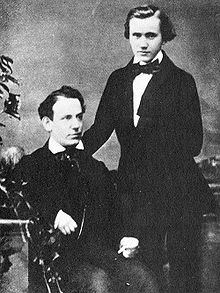
Ede Reményi and Brahms
Arnold Wehner was director of music at Göttingen, an important musical center in the north of Germany. One of the perks of his job was to host dinner parties for visiting performers and composers. Wehner faithfully kept a visitor’s journal and asked his illustrious guests to sign the book. And so we find Robert Schumann thanking him for his hospitality, and Felix Mendelssohn admiring the cooking. Franz Liszt was enthralled by the musical ambience of the city, but it was Johannes Brahms who left a true calling card. Brahms was on a concert tour with the Hungarian violinist Ede Reményi in 1853, and one of their stops brought them to Göttingen, and to Wehner’s house. Brahms was only 20 and eager to make his name, so instead of simply signing Wehner’s visitor journal, which he did by writing “zur Erinnerung Johannes Brahms” (in memory of Johannes Brahms) he also penned a little composition. Titled “Albumblatt” the composition lay undisturbed and undiscovered into the 21st century. As you might well imagine, people are still fighting as to who actually re-discovered this unknown Brahms manuscript, but fact is, the visitor book was auctioned in New York in 2012. This turns out to be a highly significant discovery as very few early Brahms manuscripts have survived. Brahms was proud to have fastidiously “burned his early musical indiscretions,” but since he left the “Albumblatt” at Wehner’s house, he was unable to retrieve and destroy it. In the event, however, Brahms actually liked the “Albumblatt” melody. He incorporated the tune, in a different key, in the second movement of his Horn Trio Op. 40, published 12 years later. So after all, there still might be hope to find the last two movements of Schubert’s Unfinished Symphony, or maybe Bach’s lost St. Mark Passion!
Johannes Brahms: Albumblatt
